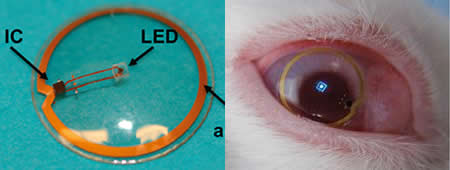A research team at University of Washington has developed a electronic contact lens which can display a one pixel as it wearing. These contact lenses are powered wirelessly at very close proximity to eyes. The research team lead by Professor Babak Parviz, have successfully tested the electronic contact lenses on live rabbits without any harm to animal’s eyes.
The team developed a contact lens embedded with a miniature LED that can control by a wireless signal. Even it’s sounds easy the mammoth task of miniaturising the devices with unconventional materials has done by Professor Parviz’s team of engineers & University of Washington ophthalmologist Tueng Shen and optoelectronics professor Markku Sopanen, from Aalto University in Finland.
These electronic contact lens can be developed in to overlay a digitally enhanced visual information in real environments, navigation systems & gaming devices. Other major advancement would be to use as a biosensor to project live body health information like hart rate, blood glucose or lactate levels. According to professor Parviz, “Some day maybe we’ll have full-fledged streaming in your contact lenses,” so watching streamed videos or replace your computer/digital screen with these contact lens won’t be that far away.
With the current version, they have used miniature custom built sapphire based LED to embed in the center of contact lens. The antenna is laid around the circular rim of the lens which connect to LED at the center. With this setup the LED can be controlled wirelessly by remote radio frequency transmission. To over come the focal length of human eye which prevents the clarity of visuals of LED, if it’s not within the right distance, they created a less than micron thick non-electronic lens containing an array of special flatter which assist successfully to focused light from the LED at the center of the contact lens.
It’s a “proof-of-concept” according to engineers, which will pave the way to produce contact lenses with multiple pixels which could lead use them as alternative to all digital screens in the future.
Information Sources: Unversity of Washington , Institute of Physics

